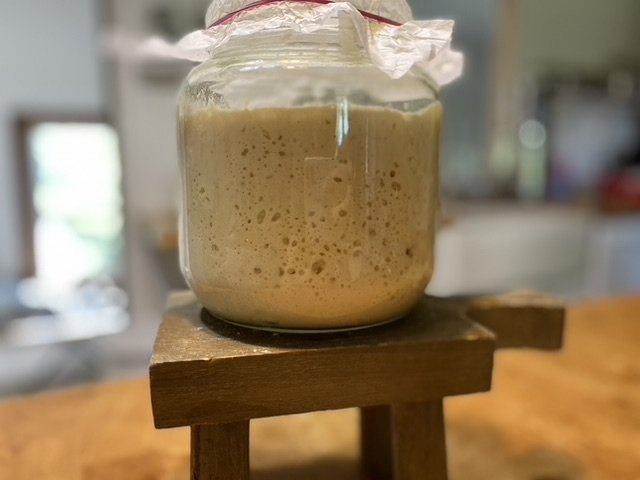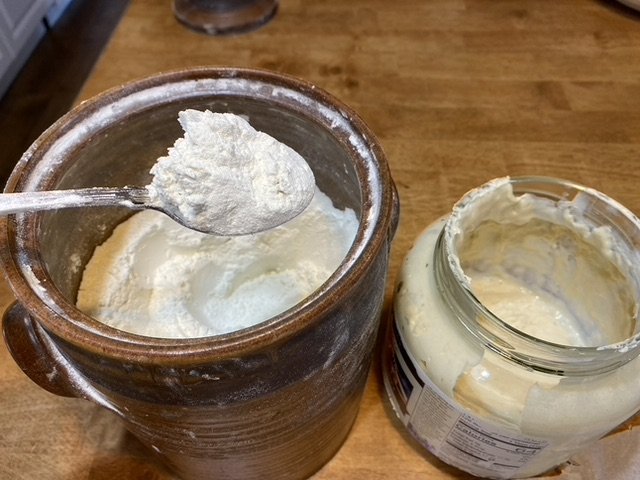Sourdough starter - the beginners guide
Sourdough starter is a mixture of flour, water, wild yeast and bacteria that forms a living culture that sourdough bread depends on in order to rise ( instead of using traditional dried yeast that most of us are familiar with)
Because sourdough starter is a living organism, it needs to be fed on a diet of flour and filtered water every day ( unless being kept in the fridge) and neglecting to feed your starter will result in eventual death - which, friends has happened to us all - I for one am guilty of having killed my starter… multiple times!!
Using the right kind of flour
Because Sourdough starter is a delicate balance of wild yeast cultures and bacterial colonies it can also die when exposed to chemicals and additives which are added to some flours.
Bleached flour - Stay away from ‘bleached’ flour, bleached flour contains chlorine which will kill the yeast cultures and you will notice that your starter begins to loose its bubbles.
Bromated flour - As the name suggests, bromated flour contains bromate, or ‘potassium bromate’ which is an oxidising additive used to improve the elasticity of flour. This additive however will also kill your precious starter so check your flour sack to make sure it does not contain this chemical.
Self raising flour - Not as bad as the above, self raising flour contains baking soda which is an alkalinising agent, this upsets the ph of your starter and so if you accidentally feed your starter with self raising flour you will probably notice it doesn’t respond too well. One feeding most likely won’t kill it but repeated use will.
other additives such as enzymes, mineral salts, emulsifiers and antioxidants can also be found in commercially available flour so do check the label before you buy.
As a general rule any flour that is “untreated” is going to be the flour you want to buy. It doesn’t have to be organic flour if you can find a good quality untreated flour however I usually go with organic all purpose flour which is an easy beginner flour to start the ball rolling and as you gain confidence you can add or experiment with different blends of different flours such as whole wheat, einkorn, rye etc.
Feeding your sourdough starter
Feeding your starter
How often you feed your starter is going to be depended on how much baking you intend to do and/or how many things you want to use it for.
When you feed your starter flour you are giving the yeast “food” and as the yeast start to eat the starches in the flour they produces bubbles of carbon dioxide gas in your starter which causes it to rise. It usually takes between 4-6 hours after feeding your starter for this process to be at its peak, at this point your starter is considered fully active and is ready to be used in baking.
If you don’t intend to use your starter every day a quart sized mason jar will be plenty of space for your starter to live. Each day stir in 1 tbsp of flour and a splash of filtered water, stir the mixture together until it resembles the consistency of a thick cake batter adjusting the amount of water and flour as needed.
After 24 hours if you did not use your starter and the mixture has ‘deflated again’ before you feed again simply pour away half of the starter mixture and then feed it again in exactly the same way as the day before.
deflated or inactive sourdough starter
The discard
The portion that you pour away is referred to as the ‘discard’. This is done to keep the starter a manageable size. If you don’t discard some of the mixture then because the yeast and bacteria have multiplied, to keep your starter happy it would require being fed more and more food each day. If you don’t feel good about pouring half your starter into the trash then get yourself inspired with a few sourdough discard recipes, there is a whole host of baked goods can be made using sourdough discard.
If, like me you want your starter to keep increasing in volume since you plan on baking a lot of bread then you might want to keep your starter in a bigger container. Each day you will need to add twice the food and twice the water that you did the day before and day by day the volume will increase proportionatley. Typically you will want 1/2 cup of starter per loaf of bread with some left over to feed for the next loaf.
Hooch
Sometimes you might notice a watery liquid on the surface of your starter, particularly if you forgot to feed it for a day. The speed at which the yeast use up the starch will depend on how warm your room is. The warmer the room the faster the fermentation reaction occurs.
When the yeast in the starter is hungry you might sometimes notice a liquid forming on the surface of your starter, this is actually alcohol ( a byproduct of the fermentation process) you can simply pour it off and feed your starter as normal to correct this.
Taking a break
Because the speed at which your starter ferments determines how much you need to be there to see to its needs some people choose to retard or “slow” the activity of their starter by keeping it in the fridge. This means it can be fed less often because at the lower temperature the fermentation process occurs at a much slower speed. I have heard some people say they can get away with only feeding their starter weekly by keeping it in the fridge which is a good thing to know if you plan on going away. Before using however the starter does need to be lifted out of the fridge, brought back to room temperature, fed and left until active before using however.
If you plan on going on vacation you can also keep a pack of dehydrated sourdough starter on hand. Dehydrating your starter at room temperature removes the water but preserves the yeast and bacteria. Its a great resource to have on hand. I keep a reserve of my own starter in an airtight container in my pantry and if i’m going away or happen to let my starter die then all I need to do is dissolve some dehydrated starter in filtered water and start feeding it as above to wake it back up again.
Restarting dehydrated starter
Making your own Sourdough starter
You’ve probably caught on by now that sourdough starter is simply a mixture of flour and water and time. Since good quality, unadulterated, organic flour contains its own yeasts and bacteria then it is possible to make your own starter simply by mixing flour and filtered water together in a small bowl and letting it sit on your counter top to “catch” the wild yeast in the air. Feeding it a little bit more each day and keeping an eye on it for bubbles will soon give you a clue as to if you have been successful.
If you rather have a head start and you don’t have a neighbour who can give you some of theirs then you can easily purchase my sourdough starter in our farm shop,
since its such an easy thing to send via mail it also makes a wonderful gift for a sourdough loving friend!





